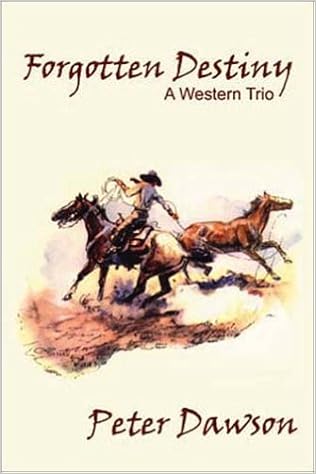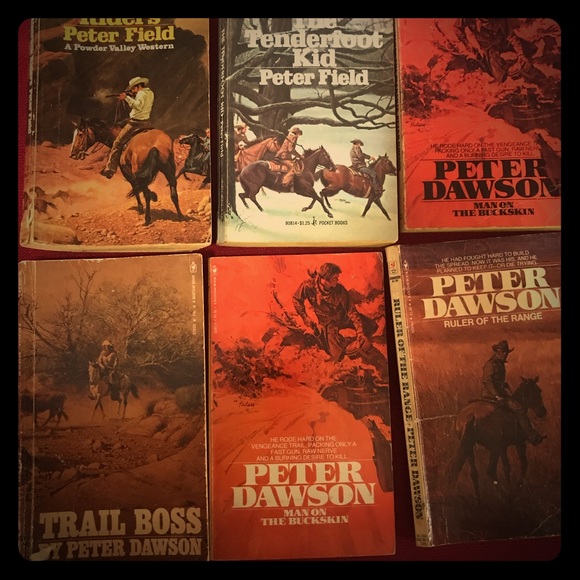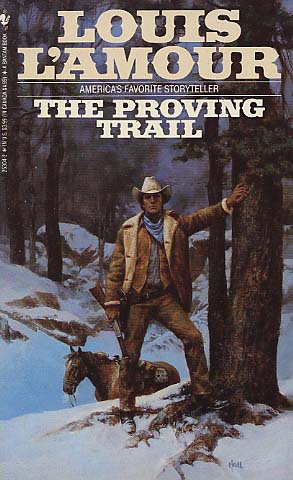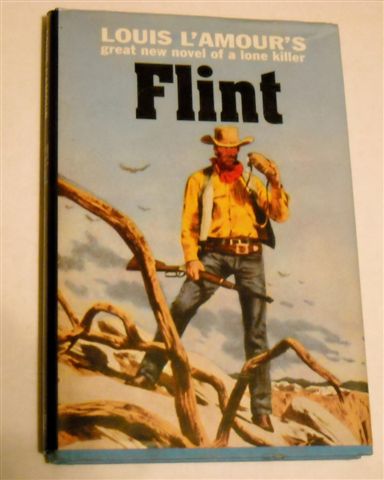
Valley of the Sun is a collection of nine of Louis L’Amour’s short stories. As the title suggests, each pice included in the anthology is a Western. None of the entries are among the noir detective shorts or sailing tales he liked to tell. That does not make the assortment bad; it just means that if you want a little variety, Valley of the Sun has that for Westerns but nothing else.
The first story in the anthology is “We Shaped the Land with Our Guns” and it is one of the best installments in Sun. Tap Henry and Ryan “Rye” Tyler, two cow punchers nearing the end of a cattle drive, discover a quite a few strays have settled in a neat little valley a few miles from the town where they are to deliver the current herd. After finishing the drive, Tap and Rye draw their pay and move into a cabin near the stray beast. They begin to fix the place up in order to start their own cattle outfit.
As they soon learn, however, the local ranchers don’t like having to make room for new men staking their claim in prime grazing land. One of the cattlemen named Chet Bayless wants them gone, in no small part because their new ranch threatens his plan to take over the territory. Unknown to him, he and Rye have a history – one that Rye knows will eventually end with lead.
“We Shaped the Land with Our Guns” is fantastic. Compact and full of action, it manages to convey the characters’ personalities quickly and completely. Nothing is missing from this tale. Reading it is like reading a book, since the story feels longer than it actually is. That is no mean feat, even for a writer of L’Amour’s skill!
Next is “West of the Pilot Range.” Ward McQueen, from Arizona, comes upon a herd of cattle protected by four men. Since two men already quit, the group is short-handed and looking for more help. The leader of the outfit, Iver Hoyt, asks if he wants a job protecting the cattle. McQueen says he does and is hired on the spot….
But something about the entire situation does not sit well with him. Hoyt and his ramrod, Red Naify, both seem too harsh and hurried. The other two hands – Baldy Jackson and Bud Fox – are friendlier and honest, so McQueen has no concerns about them, something is definitely off about the other two. When he comes upon the body of a nice young man with a good horse the night after joining the outfit, his suspicions increase. Something is definitely wrong. McQueen begins investigating the situation more thoroughly, only to become mired in a deadly rustling conspiracy.
“When a Texan Takes Over” follows the exploits of Matt Ryan. Matt has been living in the Slumbering Hills for about three months, quietly mining gold. In order to keep away from prying eyes, Matt moves his camp and stays out of everyone’s view. This means that, while they know he is around, they do not see him until he comes out in the open. And he usually becomes visible only when he goes to Hanna’s Stage Station for the food. And the girl.
Kitty Hanna helps her father run the stage station, cooking meals for passengers and drifters alike. Though she does not yet know his name, she likes Matt Ryan and makes certain to show it. But when a known rustler and his hanger on, Fred Hitch, arrive at the station, the former tries to brace Ryan. In order to avoid a fight with them in the station, Matt does not rise to their bait – something Kitty does not appreciate.
Put out, Ryan considers leaving. However, despite not being invested in the area (beyond his interest in Kitty), he respects the man who brought law and order to the Slumbering Hills. That man is Tom Hitch, the adopted father of Fred Hitch.
Tom is dying. He is also being robbed blind. His adopted son, who has very little strength of character, has been forced to go along with the stealing by the rustler he hired as a ramrod. Knowing this, Ryan makes a decision to tell Tom what is going on, only for the thieves to push Matt out. They’re just a bit late, however. Before they murder him in cold blood, Tom leaves a message for Ryan: Take over. By any means necessary.

The next story is “No Man’s Mesa.” Matt Calou bought the Rafter H, a ranch situated near Black Mesa, and has arrived to settle his claim. But he soon finds that the locals are opposed to his moving into the abandoned farm. Whenever cattle go missing, crops fail, or unseasonable weather moves in, they blame Black Mesa for the trouble. Convinced it is cursed and spreads bad luck to those who live near it, they want no one to move within the rock’s shadow and spread the evil around.
Amused by their fallacy, Matt goes to the ranch and begins settling in. He soon finds he has some pretty company; Sue Reid, the daughter of an archaeologist who lives nearby, likes to drop into the Rafter H from time to time. Visiting with Matt, she tells him that the townspeople take their superstitions about Black Mesa very seriously. Having given him a week to leave of his own accord, they plan to run him off the farm if he does not go willingly.
Knowing there must be something going on for the cattle to continuously disappear without a trace, Matt begins investigating. What he finds makes the whole picture clear. It also gives him the high card when the townsfolk inevitably come to chase him off the Rafter H.
“Gila Crossing” is one of the longer stories in the collection. Texas Ranger Jim Sartain arrives in the town of Gila Crossing, which is simmering with resentment. A fire recently burned off several acres of good grazing land. It nearly burned out a group of nesters, who purposely moved into an area that they believed would be out of the cattlemen’s way.
Despite their efforts to avoid trouble, it has arrived. One of the nesters was murdered, his animals driven off, and his house set ablaze. Coupled with the fire that destroyed the range, things look suspicious. Both sides blame the other, but neither has anything to gain in a range war. They all lose if they set the country alight with their anger. So who benefits in such a despicable situation?
Jim Sartain aims to find out – preferably before more people die.
“Medicine Ground,” the following story in the anthology, is a Cactus Kid tale. It is a bit formulaic and dry in its presentation of events, much like a Zorro or Lone Ranger story would be when it was written by someone who was not totally invested in the character. I do not know if Mr. L’Amour created the Cactus Kid – I think he was a protagonist created by someone else, but whom many writers used in various stories in order to make a sale.
While L’Amour’s tale is strong and he does put effort into it, to me, there is some genuine heart missing from the piece. It feels like something he did simply to earn a few dollars and fill space in a magazine. There is nothing wrong with that; everyone has to eat, and L’Amour was as human as anyone else. But in my opinion “Medicine Ground” is not a particularly interesting story, despite the craftsmanship that went into it.
Anyway, the Kid is heading out to a date with Bess O’Neal, a local Irish girl from a ranching family. Having missed two dates with her already, he has been warned that to miss a third will be the end of their acquaintance. To avoid that fate the Kid has dressed accordingly. Riding a piebald horse with one blue eye, he heads off to the dance at the nearby school to meet his sweetheart.
Unfortunately, his trip is interrupted. While playing poker earlier in the day, the Cactus Kid happened to notice that one of the players was not dealing fairly. Ace Fernandez, the card sharp in question, got a little greedy and missed the Kid slip his sleeve cuff over a nail. When Fernandez reached to collect the pot, his sleeve tore and the sleeve holdout he had been using was revealed. On being thus discovered, Ace reached for his iron. He was slower than one of the other players, who shot him dead.
Ace’s brothers, Lobo and Miguel, have decided that the Kid is primarily to blame for these events. Thus they lie in wait for him between the town and the school. Being a scientific as well as a betting man, the Kid knows better than to argue with two unwavering guns. However, he also knows he has to live and make the dance with Bess. With that thought in mind, he begins trying to escape…
…Only to overhear the brothers say something about a senorita.

Following this installment we have the titular “Valley of the Sun,” which begins with Brett Larane waking slowly. Wounded and left to die in the desert, his memory takes time to return. But when it does, he realizes he has to get home – fast. Having accepted a job as Marta Malone’s foreman at the Hidden Valley Ranch, he worked there even after her other hands quit, making him foreman in name only.
Deeply in love with Marta, he had hoped to start a life with her at the ranch. Now that future is in serious jeopardy. Brett knows the men who shot him will go back to the Hidden Valley Ranch. One of the men wants Marta, the others want the ranch. They already have the money he had received upon selling her horses. It will be the easiest thing in the world for them to say that he ran off with the cash and left her.
Brett does not want to die. He does not want to leave Marta. But a wounded man afoot in the desert has to be careful if he wishes to survive. For Brett to make it back to Hidden Valley Ranch, he will have to cross the Valley of the Sun. And if he doesn’t do it right, he is a dead man.
Next we have “That Slash Seven Kid,” a rip-roaring good yarn if there ever was one. Johnny Lyle is the nephew of Tom West, the owner of the Slash Seven Ranch, and his uncle loves him dearly. However, he does consider the boy a guest and a greenhorn, an opinion shared by most of the hands.
More than a little tired of their babying, Johnny sets out to find a local rustler named Hook Lacey in order to win the respect of the hands. Though free with his talk, there is nothing wrong with his hearing, and Johnny has heard that Lacey seems to like Tierra Blanca Canyon, which is near the town of Victorio. While there, he discovers three disguised Slash Seven hides at the butcher’s shop. The butcher tries to chase him off, only to be given the beating of his life.
After telling the townsfolk that he intends to deal with Hook if he rustles another Slash Seven steer, Johnny makes the outlaw angrier by falling for the girl Lacey likes. Setting out the next morning, the so-called tenderfoot knows he has to make good on his brags to a degree if he wants to be considered a hand. The problem, of course, is to do it without dying in the process.
This is a very good story, one of the best in the volume. It’s got all the heart and style L’Amour is known for, as well as a good plot and strong characters. “That Slash Seven Kid” is a tale to ride the river with. 😉
The same can be said of the final story in the collection. “In Victorio’s Country” is a fantastic piece that follows the exploits of a set of bank robbers. Red Clanahan and his men successfully rob the bank in the town of Cholla. Red’s old friend Bill Gleason, who stayed on the right side of the law as the West was won, is the sheriff of Cholla. Having set out in pursuit of Apaches, he is not present when Red and his gang make their play.
While heading for the border, Red and his three companions find a set of tracks that makes them pause. The Apaches are indeed active in the area, but the four men know how to avoid being seen by them. However, it appears there is someone else out here as well: a couple of kids, boy and girl.
Identifying their tracks leaves the outlaws in a quandary. They have more than enough money to make them very rich, at least until they spend it on gambling, drinking, and women. And although they are well ahead of Gleason, the sheriff and his posse are even now tracking them down to bring them to justice. So the question before the thieves is: do they continue south as they had planned, or do they go help these two kids?

This has to be one of the best short pieces L’Amour ever wrote. If I had to recommend Valley of the Sun on the basis of a single story, this would be it. The other tales in this anthology are worth reading, but “In Victorio’s Country” is the real prize. It epitomizes the Western ethos along with everything fans love about the genre. And it makes Valley of the Sun more than worth the purchase price.
But you do not need to take my word for it, readers! Pick up Valley of the Sun at your earliest opportunity. You won’t regret it! 😀
‘Til next time!
The Mithril Guardian























